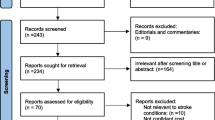Abstract
Aim: To estimate the cost of treating stroke in the UK.
Methods: A cost-of-illness model was constructed to estimate stroke-related costs over a 5-year period. The cost estimates were based on data from a large, randomised, prospective study comparing alternative strategies of stroke care. The study collected detailed data on resource use in hospital, primary care, healthcare contacts, and utilisation of social services over a period of 1 year following stroke. A Markov framework was used to extrapolate 1-year costs over 5 years.
Results: The model estimated that, for every patient who experiences a stroke, the cost to the NHS in the UK is £15 306 over 5 years and, when informal care costs are included, the amount increases to £29 405 (2001/2002 prices). The robustness of the cost findings was explored with the use of sensitivity analysis. This focused on the key variables of rates of recurrent stroke, the estimated acute costs, and costs attached to institution and home care.
Conclusion: As well as being a considerable cause of morbidity and mortality, stroke is also a huge cost burden to both the UK’s NHS and the carers of stroke victims.






Similar content being viewed by others
References
Wolfe CD, Rudd A, Beech R. Stroke services and research: an overview with recommendations for future research. London: Stroke Association, 1996
Rudd AG, Irwin P, Rutledge Z, et al. The national sentinel audit of stroke: a tool for raising standards of care. J R Coll Physicians Lond 1999; 33 (5): 460–4
Hansson L, Lloyd A, Anderson P, et al. Excess morbidity and cost of failure to achieve targets for blood pressure control in Europe. Blood Press 2002; 11: 35–45
Lloyd A, Schmieder C, Marchant N. Financial and health costs of uncontrolled blood pressure in the United Kingdom. Pharmacoeconomics 2003; 21 Suppl. 1: 33–41
Dewey HM, Thrift AG, Mihalopoulos C, et al. Informal care for stroke survivors: results from the North East Melbourne Stroke Incidence Study (NEMESIS). Stroke 2002; 33: 1028–33
Hickenbottom SL, Fendrick AM, Kutcher JS, et al. A national study of the quantity and cost of informal caregiving for the elderly with stroke. Neurology 2002; 58: 1754–9
Kavanagh S, Knapp M, Patel A. Costs and disability among stroke patients. J Public Health Med 1999; 21 (4): 385–94
Kalra L, Evans A, Perez I, et al. Alternative strategies for stroke care: a prospective randomised controlled trial. Lancet 2000; 356: 894–9
Collin C, Wade DT, Davies S, et al. The Barthel ADL Index: a reliability study. Int Disabil Stud 1988; 10 (2): 61–3
Pyke R. Markov renewal processes: definitions and preliminary properties. Ann Math Stat 1961; 32: 1231–42
Wade DT, Hewer RL. Functional abilities after stroke: measurement, natural history and prognosis. J Neurol Neurosurg Psychiatry 1987; 50: 177–82
Bamford J, Dennis M, Sandercock P, et al. The frequency, causes and timing of death within 30 days of a first stroke: the Oxfordshire Community Stroke Project. J Neurol Neurosurg Psychiatry 1990; 53: 824–9
Burn J, Dennis M, Bamford J, et al. Long-term risk of recurrent stroke after a first-ever stroke. The Oxfordshire Community Stroke Project. Stroke 1994; 25: 333–7
Scott A, Evandrou M, Falkingham J, et al. Moves into residential care amongst older people in Britain. Paper presented to the 2001 British Household Panel Survey Research Conference; 2001 July 5–7; Colchester, UK
National Statistics Online. Age specific death rates. Available from URL: http://www.statistics.gov.uk/CCI/Nscl.asp?.ID=7415&Pos=&ColRank=1&Rank=208 [Accessed 2002 Aug 20]
Bebbington A, Brown P, Darton R, et al. Survey of admissions to residential and nursing home care: 30 month follow-up. London: Personal Social Services Research Unit (PSSRU), Apr 1999. PSSRU Discussion Paper 1537
Netten A, Rees T, Harrison G. Unit costs of health and social care 2001. Canterbury: Personal Social Services Research Unit (PSSRU), 2001
Bamford J, Sandercock P, Dennis M, et al. A prospective study of acute cerebrovascular disease in the community: the Oxfordshire Community Stroke Project 1981–86: 2. Incidence, case fatality rates and overall outcomes at one year of cerebral infarction, primary intracerebral and subarachnoid haemorrhage. J Neurol Neurosurg Psychiatry 1990; 53 (1): 16–22
Beech R, Rudd AG, Tilling K, et al. Economic consequences of early inpatient discharge to community-based rehabilitation for stroke in an inner-London teaching hospital. Stroke 1999; 30: 729–35
McNamee P, Christensen J, Soutter J, et al. Cost analysis of early supported hospital discharge for stroke. Age Aging 1998; 27: 345–51
Payne KA, Huybrechts KF, Caro JJ, et al. Long term cost-of-illness in stroke: an international review. Pharmacoeconomics 2002; 20 (12): 813–25
Gage BF, Cardinalli AB, Albers GW, et al. Cost-effectiveness of warfarin and aspirin for prophylaxis of stroke in patients with nonvalvular atrial fibrillation. JAMA 1995; 274 (23): 1839–45
Caro JJ, Huybrechts KF. Stroke treatment economic model (STEM): predicting long-term costs from functional status. Stroke 1999; 30: 2574–9
Taylor TN, Davis PH, Torner JC, et al. Lifetime cost of stroke in the United States. Stroke 1996; 27: 1459–66
Moeremans K, Aliot E, de Chillou C, et al. Second line pharmacological management of paroxysmal and persistent atrial fibrillation in France: a cost analysis. Value Health 2000; 3 (6): 407–16
O’Brien JA, Caro I, Getsios D, et al. Diabetes in Canada: direct medical costs of major macrovascular complications. Value Health 2001; 4 (3): 258–65
Department of Health. National Service Framework for Older people. London: Department of Health, Mar 2001
Acknowledgements
This study was supported by a grant from Pfizer Ltd to Fourth Hurdle, a contract research organisation.
Author information
Authors and Affiliations
Corresponding author
Rights and permissions
About this article
Cite this article
Youman, P., Wilson, K., Harraf, F. et al. The Economic Burden of Stroke in the United Kingdom. Pharmacoeconomics 21 (Suppl 1), 43–50 (2003). https://doi.org/10.2165/00019053-200321001-00005
Published:
Issue Date:
DOI: https://doi.org/10.2165/00019053-200321001-00005




